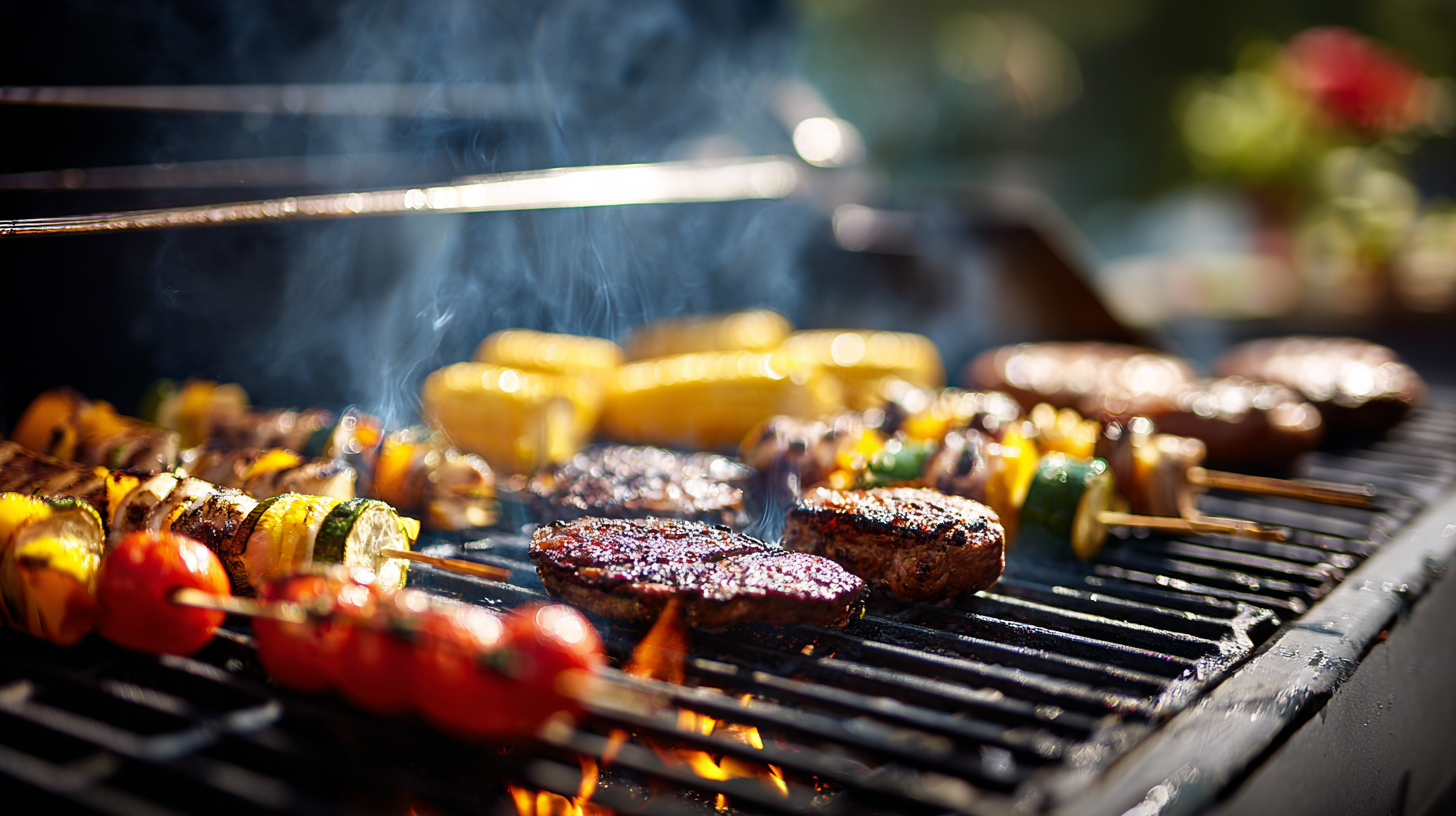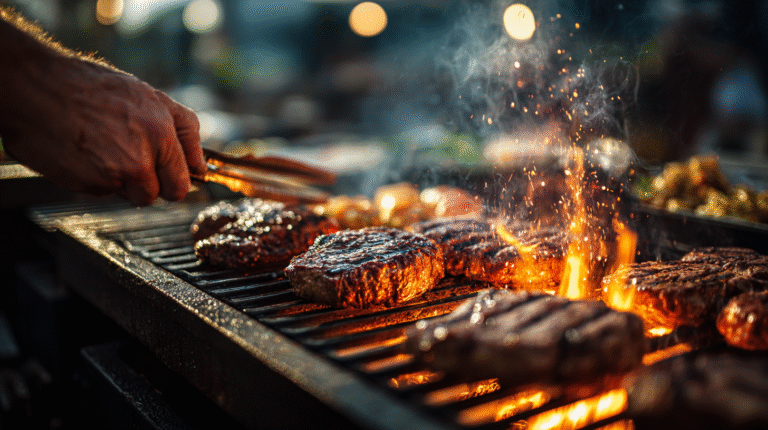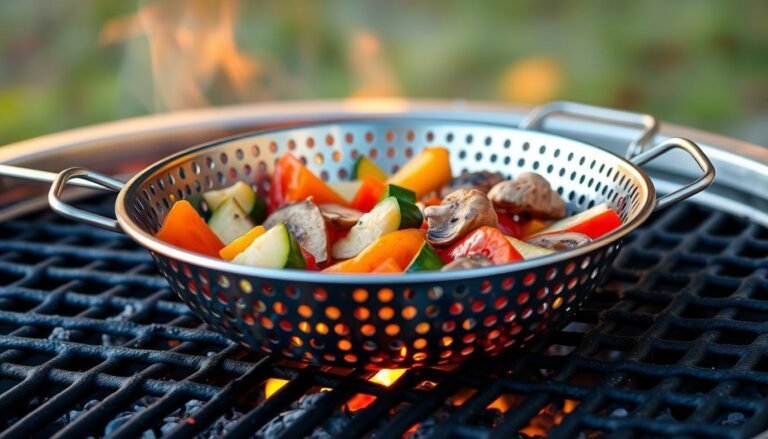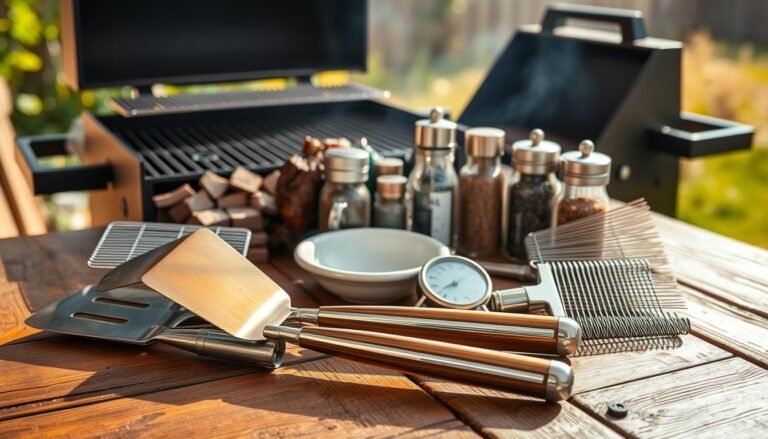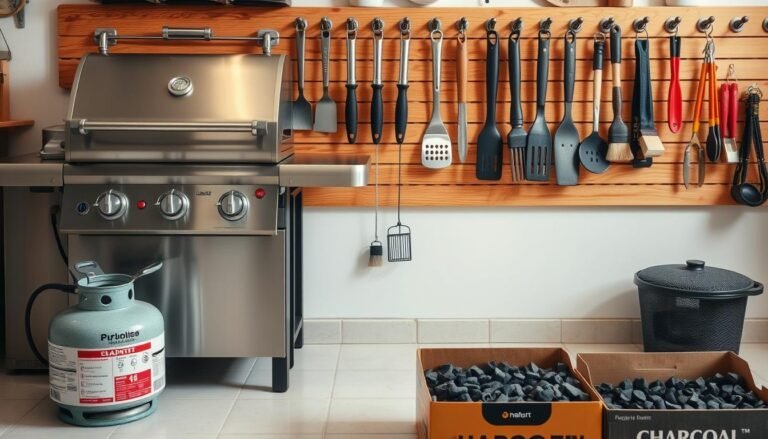Disclosure: This Post Contains Affiliate Links; We earn a commission on purchases.
Grilling is a popular cooking method that needs attention to detail. According to GrillGuru, mastering grilling techniques can make your barbecue parties better.
When grilling meats, vegetables, or seafood, following expert tips is key. You need to control the temperature, prepare the food right, and keep safety in mind. These steps are important for delicious and safe food.
Key Takeaways
- Mastering temperature control is key for grilling different foods.
- Proper food preparation is vital for tasty and safe results.
- Following safety measures can prevent accidents while grilling.
- Grilling techniques change based on the food type.
- Expert tips can make your barbecue parties better.
Essential Grilling Equipment and Setup
Grilling like a pro is more than just throwing food on the grill. You need the right tools and setup. The right equipment is key for perfectly cooked dishes.
Must-Have Grilling Tools and Accessories
You’ll need some essential grilling tools to start. A grill brush cleans the grates. Tongs or spatulas help handle food. And a meat thermometer checks if meat is cooked right.
Other useful items include grill baskets for veggies or small foods. And grill gloves keep your hands safe.
Setting Up Your Grill for Different Cooking Methods
Knowing how to set up your grill for different methods is important. For direct grilling, food goes right over the heat. For indirect grilling, it’s away from the heat for slower cooking.
Being able to switch between these methods lets you grill more ways.
Charcoal vs. Gas vs. Electric: Choosing the Right Grill
The type of grill you pick affects your grilling experience. Charcoal grills give a smoky flavor but need more work. Gas grills are easy to use and heat up fast. Electric grills are great for small spaces or easy grilling.
The right grilling equipment and setup will make you a better griller. You can try new techniques and recipes with confidence.
Mastering Temperature Control for Perfect Grilling
Grilling well means knowing how to control the temperature. This skill is key for every grill lover. It makes sure your food is cooked just right, improving taste and texture.
Understanding Direct and Indirect Heat Zones
Grills have different heat areas. Direct heat is great for quick searing. Indirect heat is better for slow cooking without burning the outside. Knowing how to use these zones is important for good grilling.
Creating and Maintaining Consistent Temperatures
Consistency is key in grilling. To keep temperatures steady, preheat your grill well and watch the heat while cooking. Adjusting vents and choosing the right grill helps too.
Using Thermometers for Precision Cooking
Thermometers are great for precise cooking. There are many types, like:
- Instant-read thermometers give quick temperature checks, ensuring food is cooked safely.
- Grill surface thermometers keep an eye on the grill’s temperature, making sure it’s perfect for cooking.
Using these thermometers helps you cook perfectly every time. It makes grilling more enjoyable.
Best Practices for Grilling Different Types of Food
Grilling meats, vegetables, or fruits can be fun. But, it’s more than just throwing food on the grill. It’s about knowing the right techniques for great results.
General Guidelines for All Grilled Foods
There are some basic rules for grilling any food. First, make sure your grill is clean and hot. Preheating is key for perfect grill marks and even cooking. Also, have your food ready to go, whether it’s marinated, seasoned, or at room temperature.
Food-Specific Timing and Techniques
Each food needs its own grilling method and time. Fish might need low heat and quick cooking. Steaks, on the other hand, do well with high heat to sear, then lower heat to finish. Knowing these food-specific techniques is essential for grilling success.
Preventing Flare-Ups and Managing Smoke
Flare-ups can ruin your food and make it cook unevenly. To avoid them, keep your grill clean, trim fat from meats, and don’t press down on food. Managing smoke means knowing your wood or charcoal and how it changes your food’s flavor. By following these grilling tips and mastering meat grilling techniques, you’ll become a grilling pro.
Expert Techniques for Grilling Meats
Grilling meats is an art that needs skill and knowledge. It’s about knowing how to handle different meats. Whether you’re new or experienced, the secret to success is in the details.
Beef: From Burgers to Premium Steaks
Grilling beef needs precision, like getting the perfect doneness. Whether it’s juicy burgers or tender steaks, the right techniques matter a lot.
Achieving Perfect Doneness Levels
Using a thermometer is key to cooking beef right. For steaks, aim for 130°F – 135°F for medium-rare. For medium, it’s 140°F – 145°F. And for well-done, it’s 150°F – 155°F.
Resting Times for Juicy Results
After grilling, let your beef rest. This makes it tender and flavorful. Steaks should rest for 5-10 minutes.
Pork: Chops, Ribs, and Tenderloin
Pork is versatile and can be grilled perfectly with the right methods. Whether it’s chops, ribs, or tenderloin, knowing the best cooking times and temperatures is important.
- Grill pork chops over medium-high heat for 4-6 minutes per side. They should reach 145°F inside.
- Ribs need a low and slow approach, often using a two-zone grill setup.
- Tenderloin should be grilled over medium-high heat, turning often, until it hits 145°F inside.
Poultry: Chicken, Turkey, and Game Birds
Grilling poultry is tricky because it’s easy to dry out the meat. But with the right techniques, you can avoid this.
Preventing Dryness While Ensuring Safety
To keep poultry moist, try brining or marinating before grilling. It’s also important to cook it to 165°F to ensure safety.
By using these expert techniques, you can grill meats that impress everyone. Whether it’s for a casual dinner or a big barbecue, the right methods and care will make your grilling stand out.
Seafood Grilling: Preserving Delicate Flavors
To keep seafood flavors fresh, it’s key to know how to grill right. Grilling seafood can make its taste better, but you must pay close attention. This is to avoid overcooking or burning.
Fish: Fillets, Steaks, and Whole Fish
Grilling fish needs special care, depending on its type. Fillets are delicate and should be wrapped in foil or grilled in a basket. This helps them stay together.
Steaks and whole fish can be grilled directly. They need a good sear to keep their flavors in. Always use a thermometer to check if the fish is cooked safely.
Shellfish: Shrimp, Scallops, and Lobster
Shellfish like shrimp, scallops, and lobster are great for grilling. They have strong flavors and textures. Shrimp and scallops can be skewered or grilled in baskets. Lobster is often halved and grilled until slightly charred.
It’s important to watch the cooking time to avoid overcooking. Overcooking can make shellfish tough and rubbery.
Using Grilling Planks, Baskets, and Foil Packets
Grilling planks, baskets, and foil packets are great for seafood. Planks give a smoky taste, while baskets keep small pieces from falling. Foil packets help keep moisture and flavor in, by steaming and grilling together.
- Grilling planks add a smoky flavor to fish and shellfish.
- Baskets are ideal for small or delicate seafood pieces.
- Foil packets are versatile and can be used for a variety of seafood and marinades.
Vegetable and Fruit Grilling Guide
Learning to grill vegetables and fruits is key to a great grilling experience. It adds a smoky taste and tender texture to any meal.
Best Vegetables for Direct and Indirect Grilling
Some veggies grill better than others. Bell peppers, zucchini, and eggplant are great for direct grilling. They cook fast and get a nice char.
For indirect grilling, try carrots and potatoes. They’re denser and need more time to get tender.
Fruit Grilling Techniques for Desserts and Sides
Grilling fruits like pineapple, peaches, and bananas makes a tasty dessert or side. Just brush them with oil, grill until caramelized, and top with cinnamon or whipped cream.
Creating Complete Vegetarian Grilled Meals
To make a full vegetarian meal, mix grilled veggies and fruits with quinoa or couscous. Add sauces or dips for flavor. Remember to turn food often and use a thermometer for the right temperature.
Some tasty vegetarian grilled meals include:
- Grilled portobello mushroom burgers
- Vegetable skewers with tzatziki sauce
- Grilled eggplant parmesan
With these tips and ideas, you can make a varied and tasty vegetarian grilling menu.
Flavor Enhancers: Marinades, Rubs, and Sauces
Make your grilled meals amazing with marinades, rubs, and sauces. These add-ons can make your food taste better and feel more special.
Essential Marinades and Brines for Different Foods
Marinades and brines add moisture and flavor to grilled foods. For example, a mix of olive oil, lemon juice, and herbs is great for chicken and fish. For more ideas, check out tips for adding more flavor to grilled foods.
Dry Rubs and Spice Blends for Enhanced Flavor
Dry rubs and spice blends are a dry option for flavor. A blend of spices like paprika, garlic powder, and brown sugar can make your grilled meats taste richer.
When and How to Apply Sauces Without Burning
Apply sauces in the last few minutes of grilling to prevent burning. Glazing adds a sweet and sticky layer to your food.
Glazing Techniques
Glazing uses a sweet sauce at the end of grilling. It creates a caramelized outside.
Regional Sauce Styles
Every region has its own sauce style. For example, BBQ sauce is popular in the South, while Teriyaki is in Japan. Each has its own unique taste.
Conclusion: Grilling Safety and Success
Grilling is more than just cooking. It needs attention to detail, the right tools, and safety. By following the safety tips in this article, you can have a great grilling time. Keeping the right temperature, handling food right, and taking care of your grill are key to great food.
Mastering grilling means knowing your grill types, using the right tools, and knowing how to cook different foods. Tips like avoiding flare-ups and managing smoke can make your food taste better. This way, you can enjoy your grilled dishes more.
Grilling safety and success are closely linked. Knowing the risks and how to avoid them makes grilling fun and rewarding. Whether you’re experienced or new, these tips will help you make tasty food and create memories with loved ones.
FAQ
What is the best way to prevent flare-ups when grilling?
How do I achieve perfect doneness levels when grilling meats?
What are the benefits of using a grill thermometer?
How do I grill delicate seafood like fish and shrimp?
What are some essential grilling tools and accessories?
How do I choose the right marinade or rub for my grilled foods?
What are some tips for grilling vegetables and fruits?
How do I prevent dryness when grilling meats?
What are some common grilling safety mistakes to avoid?

From quick grilling techniques to simple gear advice, Ryan helps beginners and busy home cooks fire up great meals without over-complicating it. Whether you’re using charcoal, gas, or a portable grill, Ryan’s goal is to make grilling approachable, fun, and full of flavor.
Subscribe to Our Newsletter

